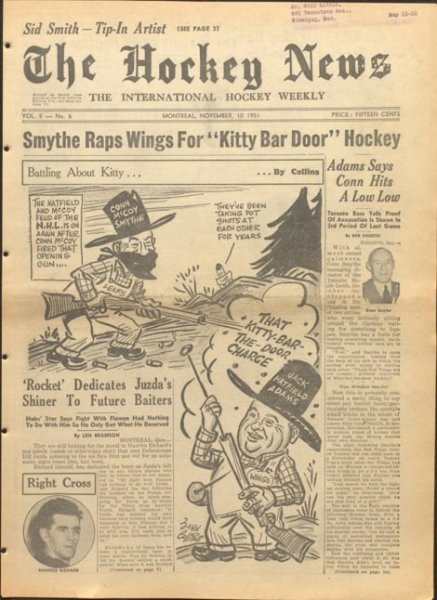
In a brazen accusation you'd never see today, Conn Smythe accused the Red Wings of "Kitty-Bar-the-Door Hockey" 72 years ago this month
In a brazen accusation you'd never see today, Conn Smythe accused the Red Wings of "Kitty-Bar-the-Door Hockey" 72 years ago this month
These days, we are accustomed to banal pleasantries when it comes to coaches or players discussing their rivals. Perhaps now more than ever, there is a sense of mutual respect and often even friendship between players and coaches from rival teams.
Just last night, Bruins head coach Jim Montgomery briefly interrupted Derek Lalonde's post-game presser to bid a friendly farewell—rapping on the glass of the Little Caesars Arena interview room with a cordial wave to a coach he's known since their days together in the USHL—after an acrimonious game between Montgomery's Bruins and Lalonde's Red Wings.
As a trip to the THN archives reveals, that level of kinship did not always exist in the NHL's coaching ranks.
The lead story from Volume Five, Issue Six of The Hockey News (dated November 10th, 1951) follows from the headline "Smythe Raps Wings For 'Kitty Bar Door' Hockey."

In the story, written by Bob Hesketh, it's revealed that Toronto Maple Leafs managing director Conn Smythe was less than impressed with the tactics of the Detroit Red Wings, under the coaching of Tommy Ivan.
Smythe told Toronto reporters that “Those Red Wings are the League’s greatest exponents of kitty-bar-the-door hockey.”
If like I did before doing a bit more research, you have little idea what the idiom "kitty-bar-the-door" is doing here, allow me to explain. Smythe believed that the Red Wings were overly passive and defensive in their approach to regular season games.
“In the playoffs,” Smythe is quoted as saying, “everybody back-checks like they have never back-checked before. But it’s the club that has the most players that can score goals when they get the chance that wins out. And the reason they can break out and score goals is that they’ve been practicing that in all the games all season. Look what Sid Smith did for the Leafs in the playoffs last season (seven goals) and what Maurice Richard did to the Red Wings in the semi-finals with those overtime goals. Detroit has a couple of pretty good artists who can break out and score but the rest of them are working back to their own net all the time. They don’t get the practice and when Stanley Cup time comes around, they haven’t the players to do it.”
“There is nothing wrong with, that kind of defensive hockey it you can get away with it,” concluded Smythe, “but it’s what I call kitty-bar-the-door hockey.”
The article resolves itself with the line "Stand by for refutation from Detroit." On the ice, that refutation would come by season's end.
Ivan's Red Wings had the league's best record in the regular season (44-14-12), led the league in goals (215), and conceded less than any team in the league (133 goals against). A +81 goal differential was 51 goals better than the next best team (Montreal). The idea that Detroit was too defensive was further undermined by Gordie Howe leading the NHL in points (86) and goals (47).
Meanwhile, Smythe's Maple Leafs scored 47 fewer goals than the Red Wings and finished 26 points back in the league table.
Whether or not their regular season could be characterized as "kitty bar the door hockey," Detroit disproved Smythe's theory that they were ill prepared for the playoffs. In the postseason, the Red Wings earned the fifth Stanley Cup in franchise history by sweeping the Montreal Canadiens.
THN Archive is an exclusive vault of 2,640 issues and more than 156,000 stories for subscribers, chronicling the complete history of The Hockey News from 1947 until today. Visit THN.com/archive and subscribe today at subscribe.thehockeynews.com
Also from THN Detroit
Red Wings 5, Bruins 4: "It's Definitely Nice to Give the Bruins a Loss"
The Silky Mitten State Episode Two
From Amsterdam to Montreal to the NHL: On Daniel Sprong's Long Journey Home

